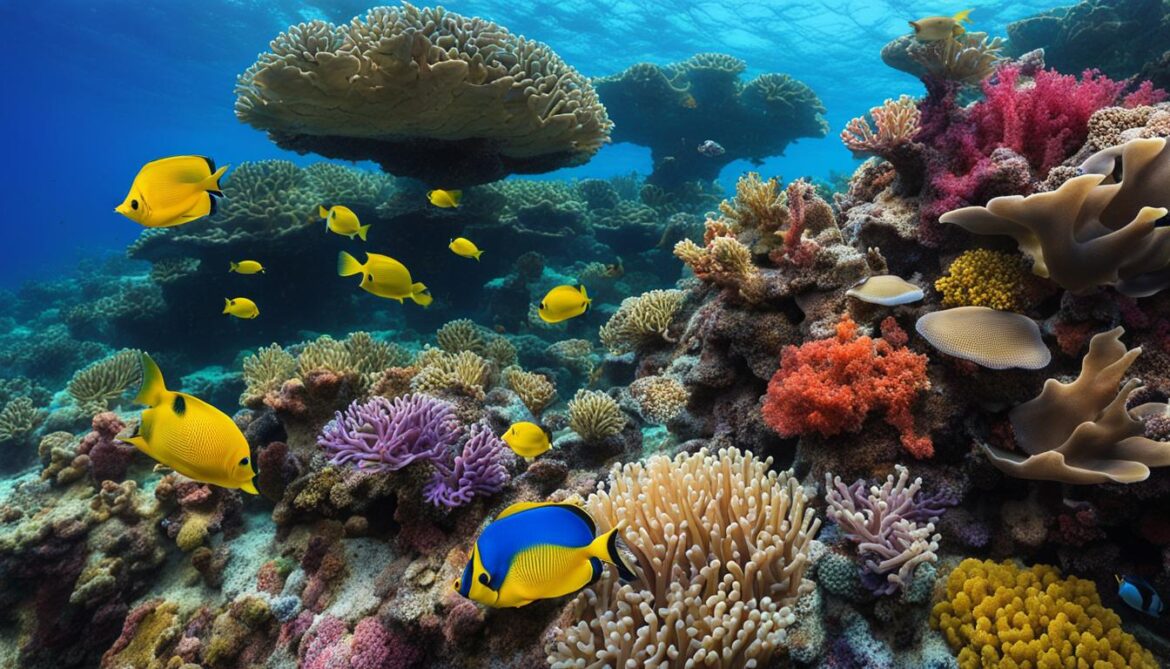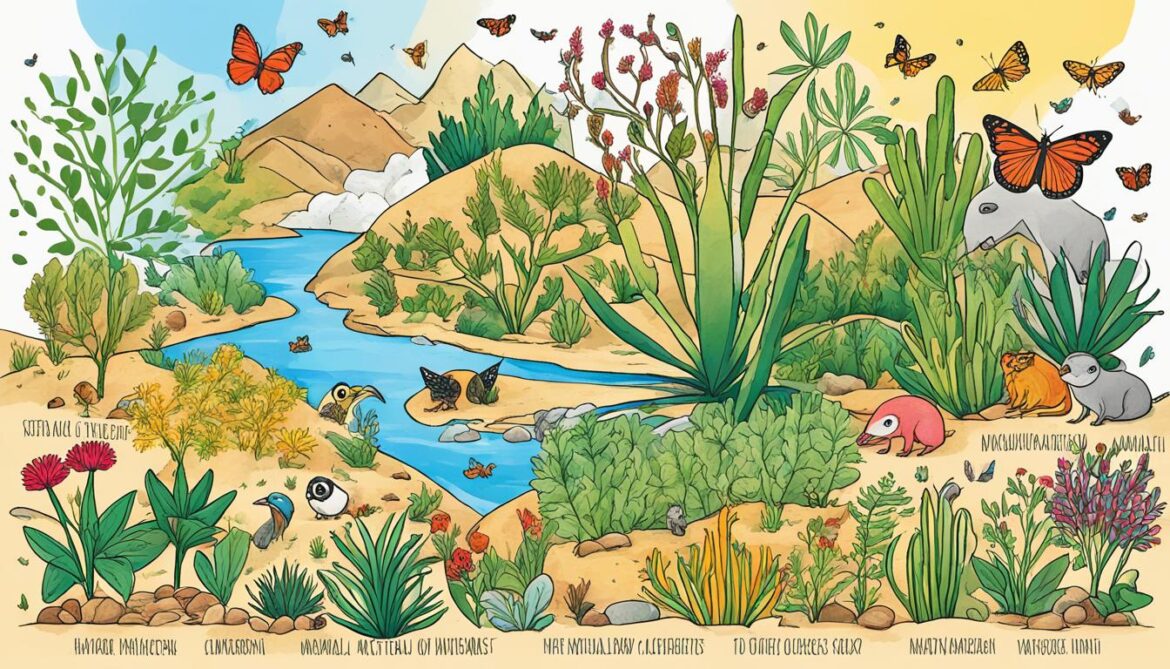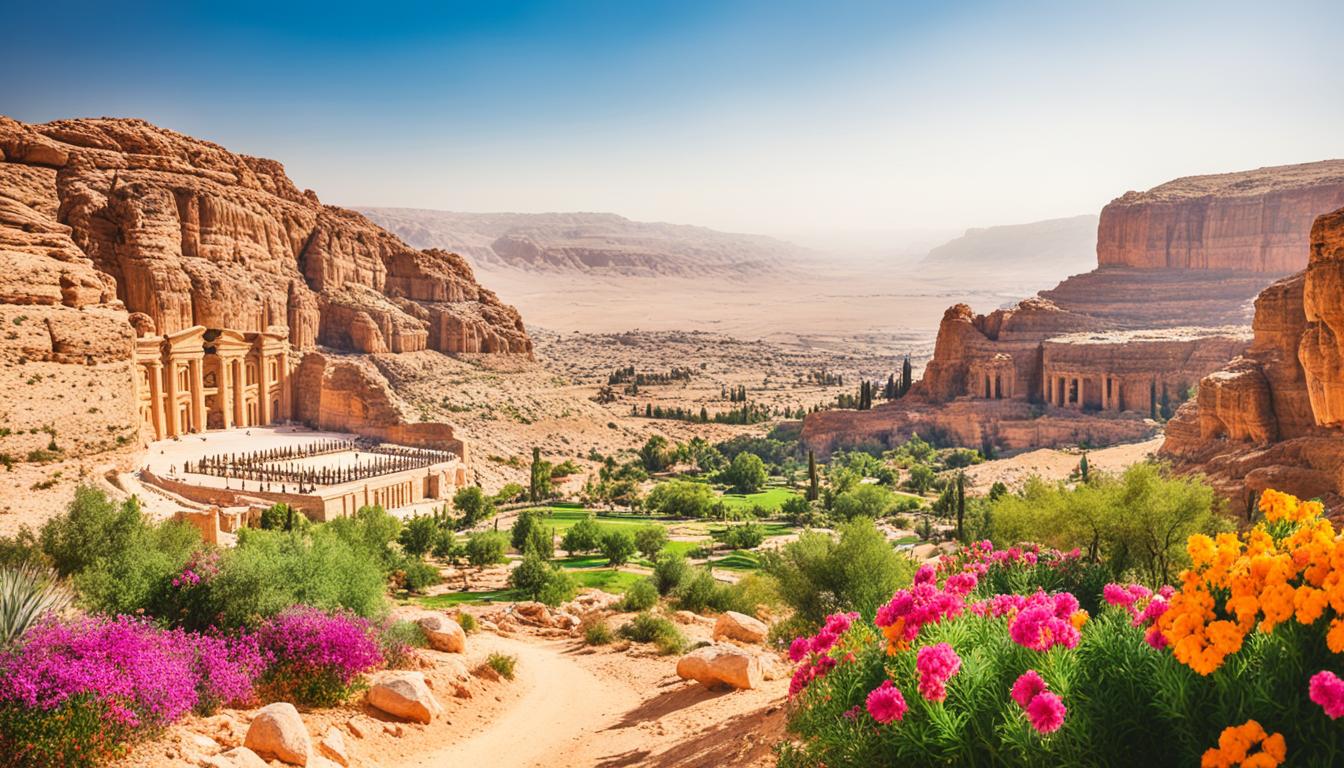Yemen Biodiversity: Animal and Plant Species and What Is Under Threat
Did you know that Yemen, a country known for its rich cultural heritage, is also home to a remarkable biodiversity? With a staggering number of over 3,000 species at risk of extinction, Yemen’s wildlife and ecosystems are facing an urgent conservation crisis. From unique plant species to iconic animals, the fate of Yemen’s biodiversity hangs in the balance.
Yemen’s ecology is teeming with a diverse range of animals and plants, many of which are found nowhere else on Earth. However, the rapid pace of development, habitat loss, climate change, and other threats pose significant challenges to the survival of these species. To protect Yemen’s natural heritage for future generations, conservation efforts and awareness are crucial.
Key Takeaways
- Yemen is home to over 3,000 species at risk of extinction
- Habitat loss, climate change, and human activities are among the major threats to Yemen’s biodiversity
- Conservation efforts and public awareness are essential to protect Yemen’s unique wildlife
- Preserving Yemen’s biodiversity is crucial for ecological balance and the well-being of local communities
- International collaboration and support are necessary to address the conservation challenges facing Yemen
Diverse Ecosystems and Habitats in Yemen
Yemen is a country blessed with a wide array of ecosystems and habitats, each offering a unique and diverse environment for its flora and fauna to thrive. From the vibrant coastal plains to the arid deserts and montane habitats, Yemen is a treasure trove of natural wonders.
Along the coastal plains, you’ll discover a mesmerizing tapestry of coastal mangroves, shrublands, and dunes that house an incredible variety of species. These coastal ecosystems play a vital role in coastal protection, providing a habitat for numerous marine and terrestrial organisms.
Just beyond the coastal plains lie Yemen’s magnificent deserts, stretching and transforming the landscape for as far as the eye can see. These arid, seemingly inhospitable regions are home to a resilient array of plants and animals that have adapted to survive in extreme conditions. The deserts of Yemen are a testament to the remarkable ability of life to persist even in the harshest of environments.
As you ascend into the mountainous regions of Yemen, you’ll encounter montane habitats characterized by cooler temperatures and unique flora and fauna. These high-elevation ecosystems not only provide a refuge for endemic plant and animal species but also attract nature enthusiasts from around the world who seek to explore the breathtaking beauty of Yemen’s mountains.
Yemen’s strategic location at the crossroads of three major biogeographic regions contributes to its rich biodiversity. This geographic diversity has resulted in a fusion of species adapted to different habitats, contributing to the country’s remarkable ecological tapestry.
Whether exploring the coastal plains, venturing into the deserts, or ascending the mountains, Yemen’s diverse ecosystems and habitats offer a true marvel of nature. Let’s delve deeper into the intricacies and wonders of Yemen’s natural landscapes and the extraordinary organisms that call them home.
Key Ecosystems and Habitats in Yemen
| Ecosystems | Key Habitats |
|---|---|
| Coastal | Mangroves, shrublands, dunes |
| Desert | Arid regions with unique flora and fauna |
| Montane | High-elevation habitats with cooler temperatures |
Flora and Fauna of Yemen
Yemen is home to a diverse range of flora and fauna, representing the country’s rich biodiversity. The unique ecosystems and varied habitats in Yemen support a wide array of plant and animal species, including many endemics. Let’s explore some of the fascinating aspects of Yemen’s flora and fauna.
Yemen Flora: Succulent Plants and Forest Resources
The flora in Yemen is characterized by its richness and heterogeneity. One notable feature is the high level of endemism among succulent plants. These plants have adapted to the arid conditions prevalent in Yemen and have developed unique survival strategies. The most iconic succulent plant in Yemen is the dragon’s blood tree (Dracaena cinnabari), which is endemic to the Socotra Archipelago. Its distinctive umbrella-shaped canopy and resinous sap make it a symbol of Yemen’s natural heritage.
Furthermore, Yemen’s forest resources are of utmost importance to the country’s economy and construction industry. The forests provide timber and serve as a source of fuelwood for local communities. Unfortunately, deforestation and unsustainable practices pose a threat to these valuable resources.
Medicinal Plants and Aromatic Herbs
Yemen has a long history of utilizing medicinal plants and aromatic herbs for various purposes. Traditional medicine in Yemen often relies on the healing properties of these plants. Many Yemenis still use herbal remedies for treating various ailments and maintaining their well-being. Some of the commonly used medicinal plants in Yemen include black cumin (Nigella sativa), frankincense (Boswellia sacra), and myrrh (Commiphora myrrha).
Yemen Crops and Birdlife
Agriculture plays a vital role in Yemen’s economy, and the country boasts a variety of crops. Local varieties of wheat, lentil, and millet have been cultivated for generations, but they now face challenges due to the introduction of high-yielding varieties. Preserving and protecting the biodiversity of these crops is crucial for ensuring food security and supporting sustainable agriculture in Yemen.
Beyond its plant life, Yemen is also home to a diverse array of bird species. The country’s varied habitats, including wetlands, mountains, and coastal areas, provide an ideal environment for birdlife. Yemen’s bird species include raptors, such as the Egyptian vulture (Neophron percnopterus) and Bonelli’s eagle (Aquila fasciata), as well as migratory birds that pass through the country during their seasonal journeys.
Yemen’s rich flora and fauna are an integral part of the country’s natural heritage, highlighting the significance of biodiversity conservation in this region.
Now, let’s take a closer look at some of the fascinating flora and fauna found in Yemen!

Endemic Plant Species in Yemen
| Plant Species | Habitat | Status |
|---|---|---|
| Dragon’s blood tree (Dracaena cinnabari) | Socotra Archipelago | Endangered |
| Socotra Desert Rose (Adenium socotranum) | Socotra Archipelago | Vulnerable |
| Socotra pomegranate (Punica protopunica) | Socotra Archipelago | Critically Endangered |
| Yemeni wild olive (Olea europaea subsp. laperrinei) | Various habitats | Near Threatened |
| Red trumpet flower (Eusystole stenophylla) | Wadi Hadramaut | Endangered |
Yemen’s Coastal and Marine Environment
Yemen boasts a stunning coastline that spans over 2,500 km, encompassing a diverse range of coastal and marine environments. From rocky and sandy coasts to saline mud flats, mangrove swamps, coral reefs, and seagrass beds, Yemen’s coastal areas are teeming with life and natural beauty.
These coastal and marine habitats play a crucial role in supporting the country’s economy, particularly in the fisheries and tourism sectors. Yemen’s fisheries sector shows great promise for sustainable development and has already become a significant source of food commodity export.
The coral reefs along Yemen’s coastline are vibrant and biodiverse, serving as critical habitats for a wide array of aquatic species. These intricate ecosystems provide refuge for dugongs, dolphins, whales, and an abundance of diverse fish populations.
| Coastal and Marine Habitats | Aquatic Species |
|---|---|
| Rocky and sandy coasts | Diverse fish populations |
| Saline mud flats | Dugongs |
| Mangrove swamps | Dolphins |
| Coral reefs | Whales |
| Seagrass beds |

Yemen’s coastal and marine resources are invaluable, supporting not only the local communities but also the broader ecosystem. The conservation and preservation of these habitats are of utmost importance to ensure the long-term sustainability and health of Yemen’s coastal and marine environments.
Threats to Yemen’s Biodiversity
Yemen’s stunning biodiversity is currently facing a multitude of threats. The diverse range of plant and animal species, unique ecosystems, and genetic diversity are all at risk from habitat loss, over-exploitation of resources, invasive species, pollution, and climate change. These threats are putting immense pressure on Yemen’s fragile ecosystems and the species that call them home.
One of the main challenges facing Yemen’s biodiversity is habitat loss. As land is converted for agriculture, infrastructure, and human settlement, natural habitats are being destroyed and fragmented, leaving little space for wildlife to thrive. Furthermore, poor agricultural practices and an expanding population exacerbate the problem, leading to further habitat degradation.
The coastal and marine environments of Yemen are also under severe pressure. Unsustainable fishing practices are destroying coral reefs and seagrass beds, important habitats for a variety of marine species. Overfishing, the cutting of mangroves, and coastal development further threaten the coastal and marine resources of Yemen, disrupting delicate ecosystems and endangering aquatic species.
Invasive species pose yet another threat to Yemen’s biodiversity. Non-native species introduced to the country can outcompete native species for resources and disrupt ecosystem dynamics. This invasion can have devastating consequences for the existing flora and fauna, leading to a decline in biodiversity.
The quantity and quality of freshwater in Yemen are also under threat. Overuse, wetland degradation, and pollution are all factors contributing to the diminishing availability of freshwater resources. This not only affects the survival of freshwater species but also impacts the livelihoods and well-being of communities that rely on these resources.
Additionally, Yemen is not immune to the impacts of climate change. Rising temperatures, changing rainfall patterns, and increased frequency and intensity of extreme weather events pose significant challenges to the country’s biodiversity. These environmental changes disrupt ecosystems, alter habitats, and threaten the survival of many species.
To address these threats and protect Yemen’s precious biodiversity, urgent action is needed. Efforts towards sustainable land management, responsible resource use, and the implementation of conservation measures are crucial. Collaborative international efforts and increased public awareness about the importance of biodiversity conservation are also vital in ensuring the long-term survival of Yemen’s unique ecosystems and species.
Conservation Efforts in Yemen
Yemen is committed to preserving its rich biodiversity through various conservation efforts. The country has established protected areas that safeguard its unique ecosystems, allowing them to thrive. Managed by local communities and non-governmental organizations, these protected areas serve as crucial habitats for a wide range of species.
In addition to the Socotra Archipelago, which is internationally recognized for its exceptional biodiversity, Yemen has designated other protected areas including the Aden Wetlands and Bura’a. These areas play a vital role in the conservation of Yemen’s diverse flora and fauna.
To inform effective conservation policies, Yemen has also made efforts to collect and analyze biodiversity data. This data is made accessible through a freely accessible portal, enabling policymakers to make informed decisions based on scientific evidence.
Yemen has developed a National Biodiversity Strategy and Action Plan (NBSAP) to guide conservation efforts and promote sustainable development. The NBSAP is continuously updated to align with global frameworks and enhance international cooperation in biodiversity conservation.
To build public awareness and engagement, Yemen has implemented educational programs and materials that highlight the importance of biodiversity conservation. These initiatives aim to inspire individuals and communities to take an active role in protecting and preserving Yemen’s natural heritage.
Conservation efforts in Yemen contribute to the global goal of safeguarding biodiversity and ensuring a sustainable future for our planet.
Yemen’s Protected Areas
| Protected Area | Location | Key Features |
|---|---|---|
| Socotra Archipelago | Off the coast of Yemen | – Outstanding biodiversity – Iconic dragon’s blood tree – Endemic species |
| Aden Wetlands | Aden, Southern Yemen | – Important stopover for migratory birds – Diverse aquatic ecosystems |
| Bura’a | Central Yemen | – Rich biodiversity – Diverse habitats – Cultural significance |
Conservation efforts in Yemen are crucial for preserving the country’s unique biodiversity and ensuring the long-term survival of its ecosystems. Through protected areas, data collection, strategic planning, and public awareness, Yemen is striving to create a sustainable future that values its natural heritage.

Socotra Archipelago: A Unique Biodiversity Hotspot
The Socotra Archipelago, often referred to as the “Galapagos of the Indian Ocean,” is home to a remarkable array of terrestrial and marine biodiversity. This remote island group, located off the coast of Yemen, is renowned for its unique flora and fauna, including the iconic dragon’s blood tree and a variety of endemic species found nowhere else in the world.
The Socotra Archipelago boasts a rich and diverse ecosystem, with landscapes ranging from pristine white sand beaches to rugged mountains and limestone cliffs. Its isolated location and unique geology have contributed to the evolution of countless endemic species, making it a globally significant hotspot for biodiversity.
One of the most distinctive features of the Socotra Archipelago is the dragon’s blood tree (Dracaena cinnabari), named for its crimson sap that is highly valued for its medicinal and cosmetic properties. This iconic tree, with its umbrella-shaped canopy and gnarled trunk, symbolizes the fragile beauty and uniqueness of the archipelago.
Additionally, the Socotra Archipelago is home to a wide range of endemic species, including the Socotra warbler, Socotra starling, and Socotra bunting. These endemic birds are not found anywhere else on Earth, highlighting the archipelago’s importance for the conservation of avian diversity.
Despite its remote location and relative isolation, the Socotra Archipelago is not immune to the threats facing many fragile ecosystems around the world. Unregulated tourism, rampant development, and the impacts of climate change pose significant challenges to Socotra’s unique biodiversity.
However, there are ongoing conservation efforts supported by organizations like the United Nations Environment Programme (UNEP) and the Global Environment Facility (GEF) to protect the Socotra Archipelago. These efforts aim to empower local communities, raise awareness about the importance of conservation, and implement sustainable practices to safeguard the archipelago’s fragile ecosystem.
“The Socotra Archipelago is a natural treasure, and its unique biodiversity is worth safeguarding for future generations. By supporting conservation efforts, we can ensure that this remarkable ecosystem continues to thrive and inspire awe for years to come.”
– Environmentalist and Conservationist
Conservation initiatives include the establishment of protected areas, the promotion of responsible tourism, and the implementation of sustainable practices in agriculture and fishing. These efforts aim to strike a balance between human needs and ecological preservation, ensuring the longevity of the Socotra Archipelago’s biodiversity.
The Socotra Archipelago serves as a powerful reminder of the importance of safeguarding our planet’s unique and irreplaceable natural treasures. Through local engagement and international collaboration, we can work together to protect ecosystems like Socotra, fostering a sustainable future for both nature and humanity.

Environmental Impact of Yemen’s Civil War
Yemen’s ongoing civil war has had a devastating impact not only on the country’s population but also on its environment. The conflict has resulted in a dire humanitarian crisis and has further exacerbated the existing environmental challenges faced by Yemen.
The civil war has led to the neglect of environmental issues, with limited resources and attention being dedicated to environmental conservation and protection. As a result, the environment has suffered increased degradation, including habitat loss, deforestation, and pollution.
One significant environmental risk is posed by the oil tanker, the Safer, which has been sitting in the Red Sea since 2015. The vessel, carrying approximately 1.1 million barrels of oil, has not undergone maintenance or repairs, posing a serious threat of sinking or exploding. If such an event were to occur, it would result in an environmental disaster, with potentially devastating consequences for marine life and coastal ecosystems.
Yemen is also experiencing the immediate impacts of climate change, which further compound the environmental crisis. The country has witnessed an increase in extreme weather events, including cyclones and floods, causing widespread destruction. Additionally, climate change has intensified water scarcity issues, exacerbating the already severe water crisis in Yemen.
“The environmental impact of Yemen’s civil war cannot be understated. It is a tragic consequence of the conflict that will have long-lasting repercussions on the country’s ecosystems and natural resources.”
The environmental crisis in Yemen is closely intertwined with the ongoing civil war, exacerbating the challenges faced by the population. Urgent action is needed to address these issues, including international cooperation and support for environmental conservation efforts within the country.

Environmental Impact of Yemen’s Civil War
| Environmental Consequences | Description |
|---|---|
| Habitat Loss | The civil war has resulted in habitat loss due to destruction and degradation of natural landscapes. |
| Deforestation | Forest areas have been cleared for various reasons, including fuelwood extraction and infrastructure development. |
| Pollution | The conflict has contributed to increased pollution, including air pollution from military activities and water pollution from inadequate sanitation systems. |
| Oil Tanker Threat | The Safer oil tanker poses a significant environmental risk, with the potential for oil spills and marine pollution. |
| Climate Change Effects | Yemen is experiencing more frequent and severe extreme weather events, such as cyclones and floods, as a result of climate change. |
| Water Crisis | Climate change has worsened water scarcity in Yemen, exacerbating the existing water crisis. |
Locally-led Solutions and Conservation Efforts in Socotra
In response to the environmental challenges facing Socotra, local communities, supported by organizations like the United Nations Environment Programme (UNEP) and the Global Environment Facility (GEF), are taking action to protect their unique ecosystem. Through Socotra conservation projects, these communities are implementing strategies to safeguard the island’s biodiversity and ensure its long-term sustainability.
Ecosystem Restoration through Socotra Nurseries
One of the key initiatives is the establishment of community-run nurseries on Socotra. These nurseries play a vital role in reforestation efforts by cultivating and planting thousands of seedlings of the dragon’s blood tree, a signature species of the island. By replenishing the degraded forests, these nurseries are contributing to the recovery of Socotra’s vegetation and promoting the habitat regeneration of various wildlife species.
Protecting Vulnerable Species: Socotra Sea Turtle Protection
Another critical aspect of the conservation efforts in Socotra is the protection of vulnerable marine species, such as the loggerhead sea turtle. Local communities are actively engaged in sea turtle conservation, monitoring nesting sites, and implementing measures to minimize threats to their breeding habitats. Through community-led sea turtle protection initiatives, Socotra is establishing itself as a safe haven for these endangered creatures.
Combating Invasive Alien Species through Socotra Invasive Species Control
Socotra faces the threat of invasive alien species, which disrupt the island’s delicate ecological balance. To mitigate this issue, local communities are leading efforts to control and manage these invasive species. By implementing invasive species control programs, Socotra aims to protect its native flora and fauna from the detrimental effects of non-native species, preserving the island’s unique biodiversity.
These locally-led conservation initiatives in Socotra are empowering communities and nurturing a sense of environmental stewardship among the inhabitants. By actively participating in the protection and restoration of their natural heritage, the people of Socotra are ensuring a sustainable future for their island’s exceptional ecosystem.

The Urgency of Biodiversity Conservation
Biodiversity conservation is a pressing global concern that demands immediate attention. Yemen’s ongoing environmental crisis serves as a stark reminder of the critical need to protect and preserve our planet’s natural resources. The alarming loss of biodiversity and the collapse of ecosystems pose significant threats not just to humanity but also to the well-being of our planet as a whole.
As the world grapples with the challenges presented by climate change and the alarming rates of wildlife extinction, it becomes increasingly crucial to prioritize biodiversity conservation. Preserving the intricate web of life that exists on Earth is fundamental to ensuring the sustainability of our ecosystems and safeguarding the functioning of crucial ecological processes.
Yemen’s environmental crisis highlights the vulnerability of biodiversity and the devastating consequences that ecosystem degradation can have on local communities and their livelihoods. Moreover, it serves as a wake-up call for the global community, urging us to take immediate action to prevent further loss of biodiversity and habitat destruction.
Biodiversity loss is not just a local issue; it’s a global problem that requires a collective response. Climate change, habitat destruction, pollution, and invasive species are some of the key factors contributing to the rapid decline in biodiversity worldwide. By prioritizing biodiversity conservation, we can mitigate the impacts of these threats and promote a more sustainable future for all living beings.
“The richness and diversity of life on Earth are fundamental to the resilience and well-being of our planet. It is our responsibility to act now and protect the biodiversity that underpins all life on Earth.” – Jane Goodall
In order to combat biodiversity loss and environmental degradation, it is imperative that governments, organizations, communities, and individuals work together to implement conservation measures and sustainable practices. This includes establishing protected areas, promoting sustainable land use and resource management, reducing greenhouse gas emissions, and raising public awareness about the importance of biodiversity conservation.
Ultimately, the urgency of biodiversity conservation cannot be overstated. By working collectively and taking immediate action to protect and restore our planet’s biodiversity, we can safeguard the future of our ecosystems, mitigate the impacts of climate change, and ensure a sustainable world for future generations.
The Role of the United States and International Responsibility
Yemen’s environmental crisis is not solely a local issue but is the result of global factors, including carbon emissions from wealthy states. The United States, as a major producer of harmful emissions, has a responsibility to address the problems arising from its environmental impact. The U.S. should recognize the importance of Yemen’s stability and the potential impacts of climate-related events on migration patterns. International cooperation and support are essential in addressing Yemen’s environmental challenges and mitigating the consequences for its population.
Carbon Emissions and Environmental Impact
The United States is one of the largest contributors to global carbon emissions, which significantly contribute to climate change. The emissions resulting from the country’s industrial activities, transportation sector, and energy production have far-reaching consequences, impacting not only the domestic environment but also the global climate.
It is crucial for the United States to take a leadership role in reducing carbon emissions and transitioning towards sustainable and renewable energy sources. By implementing stricter environmental regulations and investing in clean technologies, the U.S. can make a substantial impact on global carbon emissions and contribute to mitigating the environmental challenges faced by countries like Yemen.
Recognizing Yemen’s Humanitarian Crisis
The United States and the international community must also recognize the interconnected nature of Yemen’s environmental challenges and its ongoing humanitarian crisis. The civil war and resulting humanitarian crisis have further aggravated Yemen’s environmental problems, including resource scarcity, degradation, and the displacement of populations.
By acknowledging the environmental dimensions of the conflict and providing humanitarian assistance that incorporates environmental considerations, the international community can help alleviate the suffering of the Yemeni people and promote sustainable solutions to their environmental challenges.
International Cooperation and Support
Addressing Yemen’s environmental challenges requires a collaborative and cooperative approach on an international scale. It is essential for countries worldwide to recognize their shared responsibility in protecting the environment and supporting vulnerable nations like Yemen.
By working together, countries can share best practices, provide technical assistance, and mobilize resources to implement sustainable initiatives in Yemen. This may include supporting renewable energy projects, promoting sustainable agriculture practices, and assisting in the conservation of natural resources.
| Key Actions for the United States and International Community | Benefits |
|---|---|
| 1. Reduce carbon emissions and invest in renewable energy | – Mitigate the impact of climate change – Support sustainable development in Yemen |
| 2. Include environmental considerations in humanitarian assistance | – Address the interconnected nature of Yemen’s crisis – Promote sustainable solutions and resilience |
| 3. Foster international cooperation and support | – Share knowledge and resources – Implement sustainable initiatives in Yemen |
The United States and the international community have a vital role to play in addressing Yemen’s environmental challenges. By taking responsibility for their carbon emissions, recognizing the humanitarian dimensions of the crisis, and fostering international cooperation, they can contribute to the protection of Yemen’s environment and the well-being of its people.

Conclusion
Yemen’s biodiversity is a precious resource that is currently facing significant challenges. The country’s unique ecosystems and species are under threat from habitat loss, over-exploitation, invasive species, and the impacts of climate change. The ongoing civil war has further intensified Yemen’s environmental crisis.
However, amidst these challenges, there is hope. Conservation efforts and locally-led initiatives are striving to protect Yemen’s biodiversity. Through the establishment of protected areas, the collection and dissemination of biodiversity data, and public awareness campaigns, progress is being made towards preserving Yemen’s natural heritage.
It is essential that local communities, international organizations, and governments prioritize the conservation of Yemen’s biodiversity. The rich and diverse flora and fauna of Yemen contribute to the country’s culture, economy, and overall well-being. Moreover, biodiversity conservation is crucial for maintaining the health and resilience of ecosystems, which in turn support human livelihoods and mitigate the impacts of climate change.
In summary, Yemen’s biodiversity is a national and global treasure that must be protected. By recognizing the importance of biodiversity conservation and taking action to address the environmental challenges facing Yemen, we can ensure the long-term survival of Yemen’s unique ecosystems and species, preserving their beauty and ecological value for generations to come.







